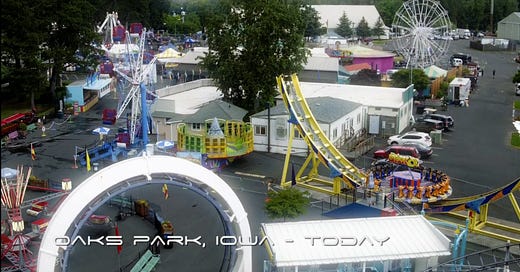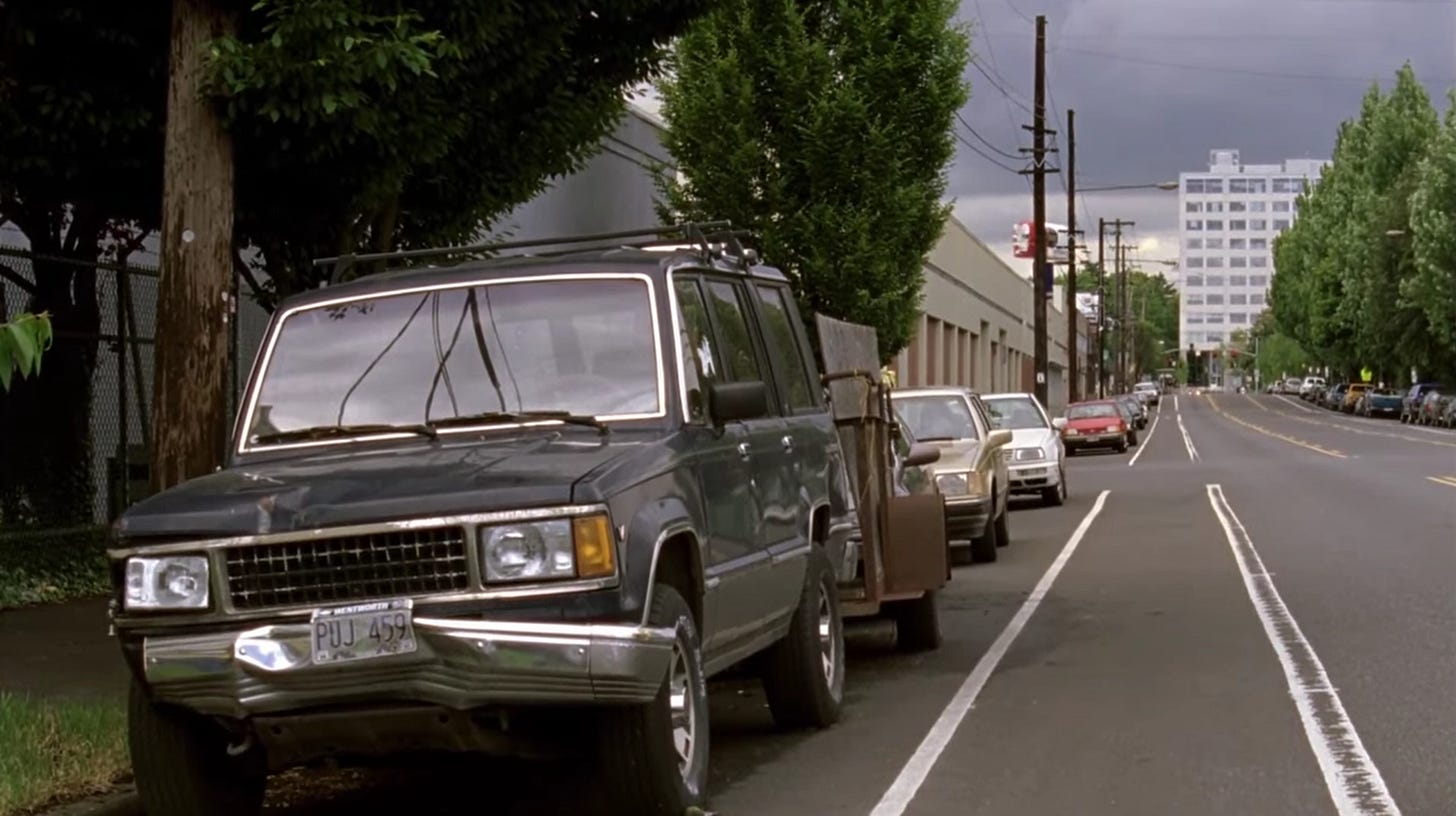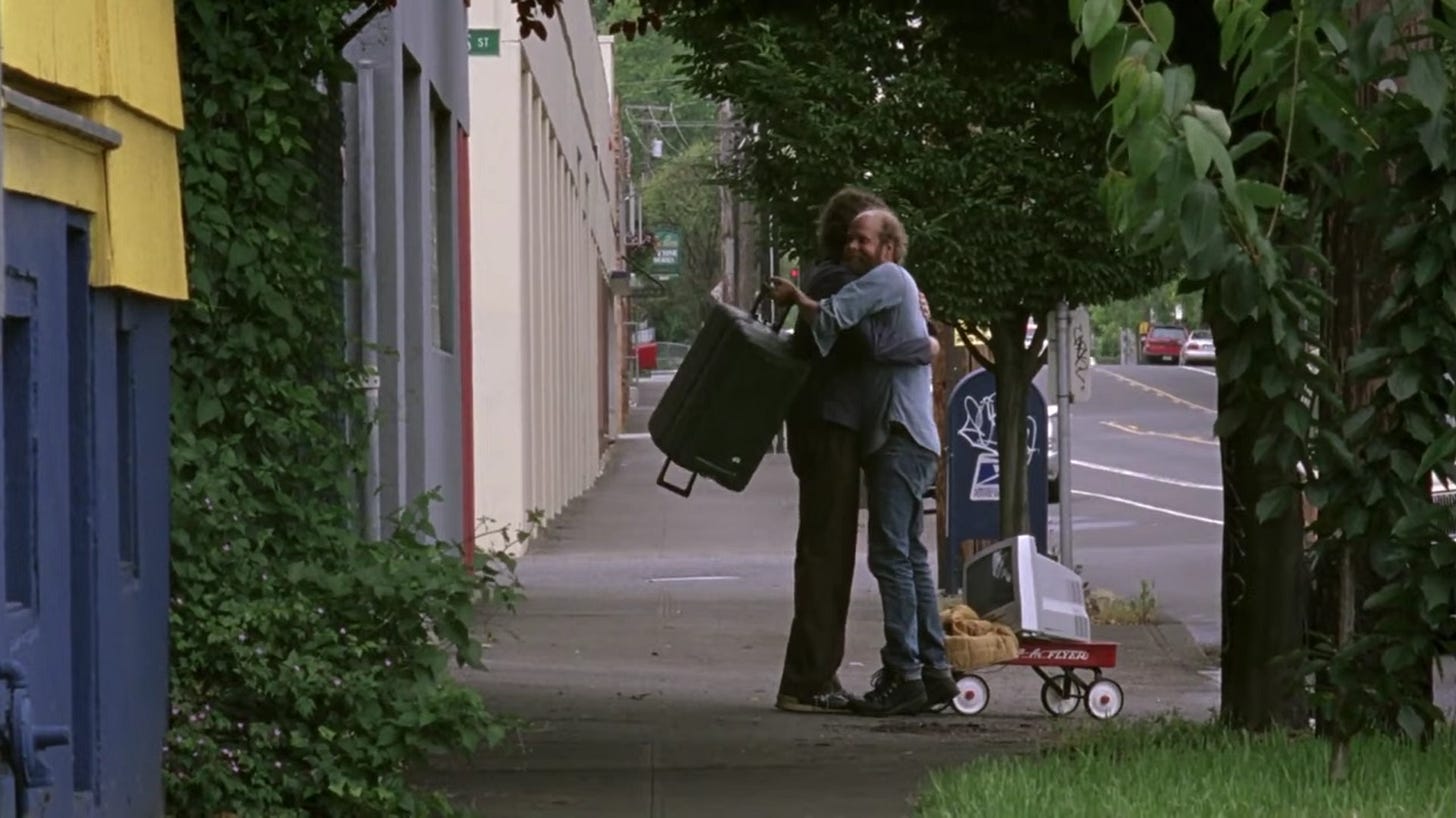Why Does Portland Look Like That?
Portland plays itself (and other places): from Kelly Reichardt to the SyFy Channel
My summer of 2016 was spent in the entertainment industry. That is operating rides at an amusement park for minimum wage. Now this may not fall in the idea of an entertainer or a blue collar imaginary of “skilled labor,”1 it does require certification2 and surely involved keeping kids entertained.3 That summer we also crossed over into the more traditional entertainment industry. A TNT drama, about librarians tasked to protect magical items from falling into the hands of evil, needed a “carnival” for an episode in their third season. Thankfully for us ride operators, those certification requirements were enough of a hurdle we were hired to run the rides for the shoot.
Oaks Park made for an almost perfect fit. While not being a drive-by-night carnival, our rides held the semblance of impermanence, partially held up by makeshift wood bases and being the same metal structures one would see in 1950s Americana depictions of “the Fair.” Not quite the glitz and glamor of Hollywood, but the shoot was the most coveted three shifts of the year and our only opportunity to make overtime. Most of the twelve hour days involved sitting in empty rides, waiting to be needed to operate a ride in the shot. Not only might we be on TV, but it came with fully catered meals, and as one of my most eager co-workers put it, “We get to meet Christian Kane AND Sean Astin, THE Samwise Gamgee!”4 I’d never heard of Christian Kane, but I am of the ilk of overeducated, downwardly mobile middle class liberal arts graduates, the target audience of a different vision of Portland.
The first night of shooting was a typical Portland late spring rain. Despite only a light drizzle for most of the afternoon and evening, the constant precipitation left puddles and a soft mist dampening the shine of lights from the rides like an almost nude filter’s obstruction. The perfect mood for the slightly sinister. However, the next two days brought a turn of weather. Two bright, sunny days and a sweltering heat in the mid-90s almost beckoning in the change of season (and more 100 degree days to come). Any discomfort the heat might have brought to the crew clamoring for spots in the shade between shoots was secondary to the continuity problems the new found natural light and lack of precipitation presented. A problem only solved by the professional sleight of hand of “movie magic.” A process demystified to me when my boss, the park landscaper, and the Best Boy were tasked with spraying hoses onto every surface down the midway. A fresh rain they’d need to replicate a couple hours later when the water evaporated in the summer sun.
Filmmaker Thom Anderson made the documentary/film essay Los Angeles Plays Itself (2003) as a lens to view how Hollywood, the studio film system, created L.A., the fictional backdrop of corruption, crime, and karmic natural disaster, shot in the real life City of Los Angeles. The studio film system made a mythical, noir City of Angels that replicated America’s fears around race, crime, terrorism, immigration, and biblical retribution while nominally featuring certain locations in an actual city of four million people.
Portland, and the Pacific Northwest more broadly, projected something else. Gaining its relevance in the industry for its flexibility in playing other places. While never being the industry machine that Hollywood was, Oregon had a bit of a movie moment. A little boutique British Columbia, itself a boutique darker Hollywood.5 As Carrie Brownstein and Fred Armison call it in the first Portlandia sketch, “a place where young people go to retire.” A place of whimsy and youthfulness, with the fantasies of enough free time to spend all your life doing your favorite hobby, and at the same time a dark place of crime and deleteriousness. Skyrocketing housing costs that led to one of the largest unhoused populations by city size, and a widespread crime panic in Portland media after a long reputation of civil protest after the murder of George Floyd and the short lived decriminalization of drugs. Now, at least in the eyes of conservative national media, Portland is where young people go to retire and die.
The Librarians came to Oaks Park in the middle of this television boom. At this time the characters' home on the show was a magical room at the base of a pillar on the St. Johns Bridge in Cathedral Park. From the late-00’s to the start of the pandemic in 2020, the City of Roses was one of its main canvases for the mid budget cable TV, a form that has largely gone the way of the puffin. Before The Librarians (2012-2018), much of the same cast and crew were in the similar campy procedural Leverage (2008-2012). There was Grimm (2011-2017), also featuring Portland as a modern city full of ancient magic. And of course, the face of this era of Portland as a brand, the IFC comedy Portlandia (2011-1018).
As much as anything twee and hipster era, Portland played the sinister, mystical version of other places. My job at Oaks Park in the Sellwood neighborhood, which features multiple boutique tea shops and multiple funky sock stores, ended up being the set for the dark and spooky clown carnival of Oaks Park, Iowa. The rainy atmospheric Willamette Valley is perfectly cloudy lighting for outdoor photography. But Oregon also is home to old growth Northwest forests, transplanted east coast/midwest trees inside the city proper, even high desert and coastline. Oregon could be dark and moody, but still a mostly blank canvas for the screen. That production companies recouped 25% of costs in tax incentives, made it so Oregon could be the boutique, made-in-America version of the Northwest film and television stronghold of British Columbia.
As Leverage and TNT dramas kicked off this era of Oregon on the small screen, the big screen Oregon maintained a reputation as a mini independent studio system for the American Independent movement. As the old cliche goes that New York is a character in the film, Portland was playing itself—the granola eating, weed smoking, Subaru driving, bicycle riding face of New Queer Cinema. This was the tale end of a decade of American independent filmmakers showing us the city. Gus Van Zant’s neo-Shakespearean Portland in My Own Private Idaho (1991), Drugstore Cowboy (1989) took us through a dingy crime ridden Old Town. Bill Forsyth’s Breaking In (1989) might have been a box office flop, but the buddy comedy had Burt Reynolds tour Rose City institutions like the colorful wood fruit facade of SE MLK’s Sheridan’s Fruit Company, the Alano Club of Portland, and yes, Oaks Amusement Park, as an aging career thief taught the next generation of safe robbery. Portland was a wild west for indie filmmakers skimming off the margins of the film industry. What better place to do that than a little west coast city with a working class charm? One that can be sunny and silly, or rainy and sinister, however the light seemed to catch it that day.
In Kelly Reichardt’s 2006 film Old Joy (produced by fellow Portland auteur and indie cinema booster Todd Haynes), two Portlander’s fading friendship and feeble eroticism is on display during a drive around the city before a camping trip. The two late 20-something layabouts Mark (Daniel London) and Kurt (Will Oldham) go on one last camping trip to Bagby Hot Springs before Mark has his first child. There’s a brief scene where Mark gives a phony offer to take his pregnant wife on the trip too, which she declines and reluctantly approves of the trip as he’s already decided he’s going to go. Kurt, who’s been to the springs before, is ripping bowls of cannabis in the passenger seat but keeps forgetting exactly where to turn off. The duo aimlessly wander along highway 26 near Estacada6 to a Yo La Tengo score.7 The trip ends up taking a full day longer as it gets too dark and they camp off the side of the highway. Their conversations are mundane, remembering a weird guy that yelled at Kurt for biking on the sidewalk, old record stores they used to visit together, the emotional tension is filled with Kurt’s unrequited longing for his friend and the inevitably of Mark’s baby being born. A feeling that this will be the last camping trip, an end to their youthful retirement, and possibly Kurt’s last chance to express his love. It ends without spoken acknowledgment, without clear resolution. But, the movie cemented Reichardt’s role as a premier filmmaker of Portland as a place.
Reichardt’s Portland Cinematic Universe is revisited 16 years later in Showing Up (2022), a humorless artist’s (Michelle Williams) quest to get her fellow artist landlord (Hong Chau) to fix her hot water heater when both have exhibits set to debut. Much the same as Old Joy it’s a slow building, meandering narrative driven comedy about absurd Portland characters. Only the Kurt’s of Reichardt’s world have new post-housing crisis anxieties. The existential malaise of the local weirdo is now driven by class, not fear of completing some bildungsroman cycle as this is hardly even an option anymore. The wannabe artist now struggles, working a job she hates going from house to art gallery to school looking for a place to shower. The “weird Portland” is now a world where those who succeed are either nepo-babies or their parents bought them a duplex to rent out.
In the two years since Showing Up came out I biked by the yellow house8 in Old Joy where Mark picks up Kurt, everyday on my way to work. While much of the neighborhood has changed, it’s still there. Hopefully a Kurt still lives there too, undoubtedly with four or five roommates.
During the television boom TNT and the SyFy Channel paid the bills, so those looking to both extract and promote an idea of the city as a haven for creative types. These tax incentives and consistent work for experienced crew were the artistic motor for the more critically accepted indie films in Portland. Films that consciously identify Portland as a place for creatives and strange people with multiple hobbies, needs to also be a particular canvas for the entertainment industry. If you could get experience holding a boom mic on that project, maybe it could lead you to something you actually want to make. Especially when paid boom mic opportunities are few and far between with the mostly bust of independent films.
When Portland played other places on TV it often maintained a grim whimsy. Dark and magical, crime lurks under each unturned tree stump, but a kind of crime where Samwise from Lord of the Rings is a magician that turns our heroes into “Freakshow” two headed ladies and snake charmers with the power of being an incel.9 It’s not unlike the dystopia conservatives would later paint the city as after 2020 protests in the wake of the murder of George Floyd had the national guard called in. Some goofy liberals have set their whole city on fire, only now it’s in Iowa!
However, since 2020 the television money is mostly gone. And the creative whimsy attached to the dark Northwest has mostly left with it. After years of downtown office vacancies, unheard of spending on police overtime pay, and still continued rising home prices, the Portland business class invented a crime crisis blaming decriminalized drug use and people forced out of their homes by poverty. During the pandemic the state feebly tried to mitigate the housing disaster by offering assistance to renters who lost income due to the pandemic, and capping rent increases at 10%10 unless the landlord wanted to pay tenants to relocate. But, in 2023 the state allowed the market to catch up for lost time, by letting landlords raise rents up to 15%, citing inflation. Landlords who were bailed out by the state’s rental assistance program, never stopped complaining about a homeless crisis of their creation, only to further squeeze Portland renters.
The New York Times, who once championed the image of “Portlandia”, now pushed this “silly city in crisis” message on a national scale. The Portland advertising economy was really all that remained of the paying creative economy. The ad giant Weiden+Kennedy set out on a new campaign, “Portland is what we make it,” coupled with new art spaces for the wealthy like SoHo House coming to town in 2023, which aims to reclaim the lost sense of a city as a bohemian playground for artists now forced back into work in the office. The business and landlord classes get to play artists again too.
While Portlandia gave the unofficial slogan, “a place where young people go to retire,” the city has an official slogan, “the city that works.” Perhaps it worked for some, when rent for a room in a punk house was $300/month. My one bedroom apartment now costs $1400/month. Nobody I know can really imagine “retiring.” Portlanders are working more than ever, just further and further from whatever creative industry was sold to them originally. Like many other cities on the west coast watching rent rise and rise, while more and more people are pushed to the outskirts or out of homes entirely.
Back in 2016, a few weeks after the Librarians shoot at Oaks Park, we had an all staff meeting. It was June 30, and the head foreman stepped on top of the picnic bench in the employee break area to let us know, “everyone is getting a 75 cent raise, starting tomorrow.” The crowd of employees erupted in cheers as our hourly rate would reach $11.25—the new legal minimum. The foreman called out our ride assignments for the day, we grabbed our metal ticket boxes, and went out for inspections. On my ticket box someone had slapped a “$15 Minimum Wage Now” sticker on it. The sticker was peeling off, just natural wear over the years, no deliberate tearing. I’d never heard anyone mention anything about it. While movie magic may not be real, sleight of hand sure is.
In fact at the time we mostly resembled service workers for the children of trade union workers that came on weekends, days off, and during Labor Day picnics for Portland’s unions. This tradition however did not return after the pandemic after a change in management discontinued the practice of accommodating the holiday celebration. This year the local AFL-CIO has struck a deal with the park for the Labor Day festivities to return to the park.
A five to fifteen minute certification training on each ride, daily safety inspections, and taking a pee drug test to get the job.
As well as cleaning up their pee and puke.
We did not get to meet either, just an assistant director named Jessie.
Now, especially post-pandemic, both are losing out to the Streaming Cartels’ poorly lit studios in suburban Georgia.
While Reichart is known for depicting a more or less accurate lived in setting for her beloved city, there is the slight directional error that shows the two driving west over the Fremont Bridge to leave town when Bagby Hot Springs and Estacada are actually east and wouldn’t require driving over the river.
A real time capsule for 30-pushing-40-something Portlanders.
On 12th and Davis.
The Librarians Season 3 Episode 5 “And the Tears of a Clown.”
Still obviously too high.








